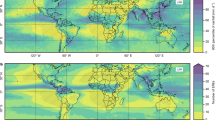Abstract
A systematic characterization of multivariate dependence at multiple spatio-temporal scales is critical to understanding climate system dynamics and improving predictive ability from models and data. However, dependence structures in climate are complex due to nonlinear dynamical generating processes, long-range spatial and long-memory temporal relationships, as well as low-frequency variability. Here we utilize complex networks to explore dependence in climate data. Specifically, networks constructed from reanalysis-based atmospheric variables over oceans and partitioned with community detection methods demonstrate the potential to capture regional and global dependence structures within and among climate variables. Proximity-based dependence as well as long-range spatial relationships are examined along with their evolution over time, yielding new insights on ocean meteorology. The tools are implicitly validated by confirming conceptual understanding about aggregate correlations and teleconnections. Our results also suggest a close similarity of observed dependence patterns in relative humidity and horizontal wind speed over oceans. In addition, updraft velocity, which relates to convective activity over the oceans, exhibits short spatiotemporal decorrelation scales but long-range dependence over time. The multivariate and multi-scale dependence patterns broadly persist over multiple time windows. Our findings motivate further investigations of dependence structures among observations, reanalysis and model-simulated data to enhance process understanding, assess model reliability and improve regional climate predictions.




Similar content being viewed by others
References
Ahrens CD (2008) Meteorology today. Brooks Cole, Belmont, CA
Alexander MA et al (2002) The atmospheric bridge: the influence of ENSO teleconnections on air-sea interaction over the global oceans. J Climate 15:2205–2231
Barabási AL, Bonabeau E (2003) Scale-free networks. Sci Am 288:60–69
Diaz JF, Hoerling MP, Eischeid JK (2001) ENSO variability, teleconnections and climate change. Int J Climatol 21:1845–1862
Donges JF, Zou Y, Marwan N, Kurths J (2009a) Complex networks in climate dynamics. Eur Phs J Special Top 174:157–179
Donges JF, Zou Y, Marwan N, Kurths J (2009b) The backbone of the climate network. Europhys Lett 87:48007
Emanuel KA (1992) Atmospheric convection. Oxford University Press, Oxford
Goddard L et al (2001) Current approaches to seasonal-to-interannual climate predictions. Int J Climatol 21:1111–1152
Gozolchiani A, Yamasaki K, Gazit W, Havlin S (2008) Pattern of climate network blinking links follows El Niño events. Europhys Lett 83:28005
Hoerling MP, Kumar A, Xu T (2010) Robustness of the nonlinear climate response to ENSO’s extreme phases. J Clim 14:1277–1293
Kalnay E et al (1996) The NCEP/NCAR 40-year reanalysis project. Bull Am Meteorol Soc 77:437–470
Kumar KK, Rajagopalan B, Hoerling M, Bates G, Cane M (2006) Unraveling the mystery of Indian monsoon failure during El Niño. Science 314:115–119
Mucha PJ, Richardson T, Macon K, Porter MA, Onnela JP (2010) Community structure in time-dependent, multiscale, and multiplex networks. Science 328:876–878
Newman MEJ (2003) Finding and evaluating community structure in networks. Phys Rev E 69:026113
O’Gorman PA, Schneider T (2009) The physical basis for increases in precipitation extremes in simulations of 21st-century climate change. Proc Nat Acad Sci USA 106:14773–14777
O’Neill LW, Chelton DB, Esbensen SK (2003) Observations of SST-induced perturbations of the wind stress field over the Southern ocean on seasonal timescales, J. Climate 16:2340–2354
Pons P, Latapy M (2006) Computing communities in large networks using random walks. J Graph Alg App 10:191–218
Schiermeier Q (2010) The real holes in climate science. Nature 463:284–287
Steinbach M, Tan PN, Kumar V, Klooster S, Potter C (2003) Discovery of climate indices using clustering. In: Proceedings of the ACM SIGKDD conference on knowledge discovery and data mining, pp 446–455
Steinhaeuser K, Chawla NV (2010) Identifying and evaluating community structure in complex networks. Pattern Rec Lett 31:413–421
Steinhaeuser K, Chawla NV, Ganguly AR (2010a) An exploration of climate data using complex networks. ACM SIGKDD Explor 12:25–32
Steinhaeuser K, Chawla NV, Ganguly AR (2010b) Complex networks as a unified framework for descriptive analysis and predictive modeling in climate science. Stat Anal Data Mining (in press)
Sugiyama M, Shiogama H, Emori S (2010) Precipitation extreme changes exceeding moisture content increases in MIROC and IPCC climate models. Proc Nat Acad Sci USA 107:571–575
Trenberth KE, Hurrell JW (1994) Decadal atmosphere-ocean variations in the Pacific. Clim Dynam 9:303–319
Tsonis AA, Roebber PJ (2004) The architecture of the climate network. Physica A 333:497–504
Tsonis AA, Swanson KL (2008) Topology and predictability of El Niño and La Niña networks. Phys Rev Lett 100:228502
Tsonis AA, Swanson KL, Roebber PJ (2006) What do networks have to do with climate? Bull Am Meteorol Soc 87:585–595
Tsonis AA, Swanson KL, Wang G (2008) On the role of atmospheric teleconnections in climate. J Clim 21:2990–3001
von Storch H, Zwiers FW (2002) Statistical analysis in climate research. Cambridge University Press, Cambridge, UK
Watts DJ, Strogatz SH (1998) Collective dynamics of ‘small-world’ networks. Nature 393:440–442
Yamasaki K, Gozolchiani A, Havlin S (2008) Climate networks around the globe are significantly affected by El Niño. Phys Rev Lett 100:157–179
Zelinka MD, Hartmann DL (2009) Response of humidity and clouds to tropical deep convection. J Clim 22(9):2389–2404
Acknowledgments
This research was performed as part of a project titled “Uncertainty Assessment and Reduction for Climate Extremes and Climate Change Impacts”, which in turn was funded by the initiative called “Understanding Climate Change Impact: Energy, Carbon, and Water Initiative”, within the LDRD Program of the Oak Ridge National Laboratory, managed by UT-Battelle, LLC for the U.S. Department of Energy under Contract DE-AC05-00OR22725. Nitesh Chawla was supported in part by the National Science Foundation under Grants OCI-1029584 and BCS-0826958. The United States Government retains a non-exclusive, paid-up, irrevocable, world-wide license to publish or reproduce the published form of this manuscript, or allow others to do so, for United States Government purposes.
Author information
Authors and Affiliations
Corresponding author
Electronic supplementary material
Below is the link to the electronic supplementary material.
Rights and permissions
About this article
Cite this article
Steinhaeuser, K., Ganguly, A.R. & Chawla, N.V. Multivariate and multiscale dependence in the global climate system revealed through complex networks. Clim Dyn 39, 889–895 (2012). https://doi.org/10.1007/s00382-011-1135-9
Received:
Accepted:
Published:
Issue Date:
DOI: https://doi.org/10.1007/s00382-011-1135-9




